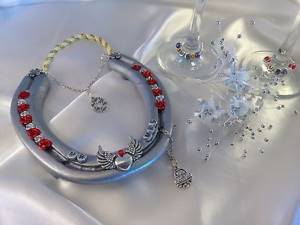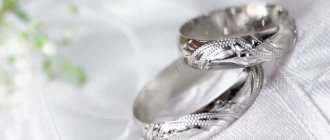Wedding in different countries: signs and superstitions
The property of ancestors and following folk traditions will help protect the bride and groom from homewreckers and envious people. Wedding amulets, as well as signs and superstitions of the ancient Slavs, which constitute the heritage of our ancestors, will come to the aid of our contemporaries. Armed with ancient knowledge, it is easy to repel any invisible and hidden enemy.
In pagan times, weddings were taken very seriously, because it was one of the three main events in the life of the ancient Slavs. The bride's dowry began to be collected from early childhood. When a young wife moved to her husband’s house, she inherited many things passed down in the family from generation to generation, and these were not only jewelry, but also family amulets.
An interesting tradition was that the parents of the newlyweds made amulets for their wedding. The Slavs believed that the power of the amulet depended on the skill of the needlewoman.
Therefore, protective amulets were trusted to be made only by experienced needlewomen - the eldest women in the family: grandmothers and mothers, less often - older sisters.
Signs and superstitions associated with the wedding ceremony were in use at different times among many peoples. In Ancient Rus', for example, the following custom was widespread: after a young wife left for her husband’s house, the floors in the room where the wedding was held were washed. It was considered a very bad sign to drop a ring during a marriage ceremony, or to stumble on the threshold of your new home.
The ancient Britons believed that leadership in the family would depend on who entered the new family home first - the bride or groom. In Britain, it was also customary to attach tins and bells to the car of newlyweds going on their honeymoon. It was believed that in this way the newlyweds were protected from the evil eye and damage. In Ancient Greece, it was customary for newlyweds to attach money to their outfits during the dance. It was believed that such money would bring wealth to the newlyweds’ home. It was also customary among the Greeks to send children into bed with the newlyweds before the wedding night. According to legend, if this is not done, the new family will remain childless.
In Italy, newlyweds broke dishes right during the wedding feast: the more fragments, the more happiness they will get!
Residents of Poland believed that it was a bad sign for a bride to wear open shoes to her wedding. And in Bulgaria it was considered bad luck to send the bride’s dress to the wash before the birth of the child.
Wedding amulets: talismans for newlyweds
A wedding is undoubtedly one of the most important days in the life of any family. But this bright and joyful holiday can easily be overshadowed, because newlyweds are especially vulnerable to the evil eye and damage.
To protect yourself and your loved one from envious people and homewreckers, you need to turn to the heritage of your ancestors. The Slavic heritage, consisting of amulets, omens and superstitions, will help protect you from any troubles. We will tell you what wedding amulets there are and how to use them correctly. Armed with this knowledge, you will fight back against any evil!
Popular wedding amulets, meaning for the bride and groom
As a rule, many guests are invited to a wedding, both from the groom and the bride. Of course, not all of them know each other or the newlyweds, so it is difficult to imagine what can be expected from unfamiliar people. Among them there are envious people, home-wreckers, and people with bad intentions.
To protect the newlyweds from the evil eye and black magical influences, it is imperative to take care of wedding amulets. It should be borne in mind that they are allowed to be given only to the parents of the bride and groom. Sisters and grandmothers give wedding gifts, but not protective talismans.
Charms for the bride
It’s hard to imagine a classic bride’s outfit without a veil. At wedding feasts in Ancient Rus', not only the head, but also the shoulders of the bride were covered with a long veil. The purpose of the veil as a talisman is to protect the bride from the evil eye and intrigues at the wedding, as well as when moving to a new family in the groom’s house.
It is believed that a veil cannot be sold, given away or thrown away, otherwise a woman’s happiness may go along with it. At the birth of the first child, it was customary to cover the child’s crib with the mother’s wedding veil to protect the child from illness and disease.
Before the wedding ritual, it is recommended to pin an evil eye pin to the underside of the hem of the wedding dress. This amulet will not allow damage to be caused. The flowers that make up the bride's bouquet are, among other things, a strong talisman. An important point: the wedding bouquet should be composed of flowers that both newlyweds like. It is believed that in this case their marriage will be happy. The energy of flowers such as roses, callas, orchids will attract wealth, protect against conflicts and outside influences on the affairs of a young family.
A faithful and reliable amulet is a baptismal cross, consecrated in the church. It should be hidden under the corset, near the heart. A believing girl on the morning before the wedding is recommended to wash herself with holy water and read the Our Father.
Charms for the groom
At a wedding, they try to throw various negatively charged little things at the groom more often than the bride that can destroy family harmony.
To protect against the hidden actions of ill-wishers, the groom, as well as the bride, is recommended to pin a safety pin on the back of the suit. Regular salt will do for the evil eye. A little salt should be poured into a paper bag and simply put in the groom’s suit pocket. You can also put a few rowan berries there. This plant has protective properties. You can put yellow coins in the shoes of the newlywed as a talisman.
It is recommended that the groom put one flower from the bride’s bouquet in his suit pocket. It is better to choose iris as a wedding amulet.
Wedding rings
The most powerful wedding amulets are wedding rings. They will protect the family for many years, but under certain conditions: • engravings and drawings cannot be applied to wedding rings; • it is not recommended to use stones in wedding rings; • both wedding rings must be purchased at the same time; • you cannot use other people's wedding rings on your wedding day; For the wedding ritual, only new ones are needed. The sacred meaning is inherent in the ritual of the newlyweds exchanging rings. It is believed that a wedding ring is a symbol of the unification of the newlyweds’ destinies, the merging of their energy into a single whole.
Festive loaf
A loaf or cake is a traditional amulet at a wedding. But there is practically no magical power in store-bought confectionery products. The wedding loaf must be baked with your own hands. It is advisable that this be done by a relative of the bride who is happily married. Elements of a wedding loaf have their own protective power: • birds will maintain marital fidelity and protect against betrayal; • floral ornament symbolizes harmonious relationships in the family; • geometric ornament is a sign of the unity of two loving people with Divine powers.
Traditional towels
The bride must embroider towels for the wedding in advance, and it is preferable to do this alone. Advice from even the closest people is prohibited.
At a wedding, a towel will protect the newlyweds from the evil eye and the intrigues of ill-wishers. The towel is used in the ceremony at the moment of blessing the young parents in front of the icons. At this solemn moment, the newlyweds stand on a towel embroidered by the bride’s hands.
Then the hands of the newlyweds are tied with a towel for a short time so that their love is strong and lasts a long time. According to legends, a wedding towel is the keeper of peace and harmony in the house. Newlyweds receive the patronage of the Family if at their wedding they use a towel, which has been passed down in their family from generation to generation.
Parental blessing
After the marriage, the mother or father of one of the newlyweds says words of blessing, congratulating the newlyweds on their marriage. According to tradition, these should be words of prayer. But in modern life they can be replaced by kind and warm parental wishes.
Words of blessing spoken from the bottom of the heart, their good energy will be able to protect the union of two hearts from many troubles. If orphans who have no parents enter into a marriage union, their godparents or imprisoned parents bless them for marriage.
Shedding
Not only in Russia, but also in other countries, there is a popular tradition of showering newlyweds with rice when they go to rest. Before this, the mother or father hands the lovers a handful of rice. It is recommended to keep it above the spouses’ bed for a year. According to legend, this amulet protects a young family from financial problems.
Rice in this case symbolizes abundance and fertility. The ritual of showering rice on the newlyweds means wishing wealth, prosperity and many children to the new family,
The meaning of the wedding
The wedding is the oldest amulet, which symbolizes the fusion of clans forming a single whole. He directs all his energy to the well-being and happiness of his new family. In appearance, this is an amulet that depicts four rings connected to each other, on the other hand they imitate two open eights also connected to each other. Such elements were chosen for a reason, because the ring represents the cycle of nature, and the eights have the meaning of an infinity symbol.
It is not recommended to give this amulet to unmarried girls or unmarried guys. No negative consequences should be expected from such a gift, but the person will not receive any benefit from it either. The main purpose of the amulet is to preserve peace, warmth, prosperity, love and happiness in the family. The colors of the wedding dresser's amulet are blue and red.
Protecting the newlyweds' car
To protect the newlyweds' car, it is recommended to hang a sachet of salt in the cabin. Instead of salt, you can use dry herbs that have protective properties. You can use them to make a small dried bouquet and hang it above the rearview mirror.
To protect the newlyweds' car, it is good to use small icons with the faces of Saints placed on the dashboard.
Red ribbons, balls and other red wedding accessories, similar to red thread, can also provide effective protection to the newlyweds’ cars.
Dress color
Recently, for their wedding, brides, wanting to show themselves as a free and independent woman, sometimes choose not a white, but a green or red dress. But the signs and beliefs of our ancestors tell of completely different traditions.
The canonical color of the bride's dress is white. It is in white dresses that Orthodox Christian women marry their husbands in church. The white color of the bride's dress symbolizes her purity and innocence. There is a special sacred meaning in this tradition. The word “bride” consists of two syllables – “ne” and “west”. Etymologically, this means “no news,” that is, the bride is a pure innocent girl who has not yet undergone sexual initiation (she is not yet “guilty” of sexual sin).
Accordingly, if the bride's dress is red or another color, this will have the opposite meaning. This is a sign that an experienced woman is getting married. This is acceptable if she remarries.
Wedding amulets made of natural stones
Since ancient times, it was customary that brides wore a lot of jewelry to their wedding, thereby attracting happiness and good luck. Today, wedding jewelry made from natural stones is again in fashion.
Pearl necklaces in light shades are a symbol of the beauty, purity and tenderness of the young bride. Pearls symbolize family peace and well-being and give their owner unfading beauty.
Wedding necklaces made of white agate will bring longevity and fidelity to the bride in family relationships. Diamond jewelry on the newlywed will tell not only about the respectable position of her chosen one, but also that the newlyweds’ marriage will be as strong as a diamond.
Marriage-protecting prayers
In Orthodox culture there are many prayers to strengthen peace and harmony in the family, to protect the home from intruders, so that faithful and devoted love reigns in it. To protect your family and friends, your marriage and children, it is recommended to read prayers - amulets - as often as possible.
To conduct a prayer ritual, it is recommended to visit an Orthodox church, buy several church candles, draw holy water, and submit notes about the health of all family members. Place candles at the icons of Jesus Christ, Nicholas the Wonderworker, and the Blessed Elder Matrona of Moscow.
Then you should choose the right time to perform prayers at home. You need to light candles and place a vessel with holy water next to the icons. Next, you should ask the Lord God for forgiveness for yourself and all household members. Orthodox prayers and amulets should be read in the following sequence:
- Prayer “Our Father” - 3 times;
- Prayer to the Holy Spirit – 3 times;
- Initial prayer – 3 times.
We protect the newlyweds
Prayers protect
To protect the bride and groom from damage, you can cast a spell on the water and give them both to drink. For such conspiracies, different prayers are used. Here is one of them:
In the name of the Father, and the Son, and the Holy Spirit.
Come down from the clouds, go around the seven church domes,
Wax seals, locks, holy keys.
Whoever thinks evil will think evil,
Close your lips, close your teeth, take away your tongue.
There is no end to that word, there is no harm from an evil person.
Key, cross, lock, psalter. In the name of the Father, and the Son, and the Holy Spirit. Now, forever and ever. Amen.
Such a talisman will help protect the newlyweds from bad weather that can bring to the newly created family during the wedding ceremony.
Wedding dress - a talisman to protect family happiness
Family has always been the most important thing for our ancestors. The birth and upbringing of children was considered the main duty to the Family. Naturally, the Svadebnik amulet occupied an important place in Slavic culture. Unlike all other Slavic amulets, it was given only to newlyweds for a wedding.
The wedding dress consists of four intertwined rings. Outwardly, it resembles two figure eights connected to each other perpendicularly. Upon closer study of this sign, you can find a symbol of the Family in it. In this case, none of the rings is closed. The roundness of the sign symbolizes harmony and equality in the couple.
History of origin and significance
The tradition of giving a wedding as a talisman for a wedding originated in pagan times. This talisman helped the newlyweds overcome life’s difficulties and protected the family from quarrels and external negativity. The Slavs gave the bride and groom a wedding dress after the wedding ceremony. Its meaning is to protect newlyweds and help them create a full-fledged family and have children.
What can an amulet be made from?
In addition to the Wedding amulet in the form of rings and rings, in pagan times it was certainly supplemented with embroidery made on the clothes of the newlyweds. Currently, this type of applied art is not very popular. Therefore, those who want to have a hand-made Wedding amulet are recommended to make knitted paired bracelets. They can be made from threads or beads.
Wedding ring
This type of amulet consists of paired rings for the bride and groom with the symbol of the Bridegroom. They had to be worn without taking them off until the first child was born in a young family.
An important detail: the Bridegroom’s rings are not closed due to the fact that the union of two hearts was considered incomplete. The intertwining of two eights symbolized the unity of the Family with the Earth. Prolongation of the family line of the newlyweds transformed the double eights of the Wedding Man into the sacred nine, which completed the effect of the wedding amulet.
Gifts-amulets ↑
There are only a few people with bad intentions at a wedding, or they are random passers-by; the rest of the guests are friendly towards the newlyweds and really wish them all the best. Gifts from invited friends and family can protect a newly formed family from the evil eye. A popular option is Lovebirds dolls, made by hand or to order. Two dolls, having one common hand - the meaning of unity, will become eternal family guardians.
An ancient amulet against evil spirits is a horseshoe.
According to legend, the Evil One approached the blacksmith with a request to shoe him. Having prayed, the blacksmith began to nail the horseshoe, but the Evil One could not stand the pain from the work that was preceded by the prayer. The blacksmith did not stop the work, then the Evil One, exhausted from torment, promised to fulfill his every wish. The blacksmith wished him not to go into the houses where the horseshoe hung.

A silver horseshoe will protect your home from evil spirits
A silver or copper horseshoe will protect your home from evil spirits and will bring prosperity and health.
It is appropriate to give a miniature broom. Decorated with wheat, beans, nickel, rowan, garlic, the broom symbolically sweeps away enemies, quarrels, and protects against witchcraft. You can present a hand-embroidered picture, pillow, tablecloth. A good thought put into embroidery, fantasies about how the newlyweds will be delighted at the sight of a gift and will live happily ever after, certainly become a good talisman.
Feng Shui to activate the love and marriage sector
According to Feng Shui, the zone of love and marriage is located in a residential area in the southwestern part. You can find it using a compass or Bagua table.
The main element of the love and marriage sector is Earth, which gives rise to the element Fire. The main colors of the love zone are pink, red and all fiery ones, which complement the shades of the Earth - yellow, brown, sand.
It should be borne in mind that only paired items can be in the zone of love and marriage: pillows, candlesticks, and animal figurines. Paired mandarin ducks, doves or swans will help activate the sector of love and marriage.
To activate the sector of love and marriage, you should install paired candles in this zone in shades corresponding to the elements of Earth and Fire, or paired aroma lamps, onto which it is recommended to apply jasmine, rose or cedar oils. Paired lamps – sconces – are also suitable. All this should be lit as often as possible!
Plant power
As an addition to the main wedding gift, in the old days, newlyweds were given amulets made from plants. It was believed that:
- a bean-shaped amulet helps replenish the family after the wedding; • millet can protect the bride and groom from the evil eye; • garlic is able to stop unclean spirits; • red pepper will increase male strength; • Rowan will prevent harm caused by witchcraft.
For example, to protect the bride from the evil eye at a wedding, it is recommended to put rowan leaves under the insoles of her shoes.
Loaf and Rushnik
The choice of a baker who will be trusted to bake a loaf of bread must be approached very seriously, observing ancient traditions. This should be a close relative of the bride (mother, aunt, sister) or any woman who has been in a happy marriage for a long time.
After the wedding ceremony, the fragrant amulet is distributed to all the people gathered around so that they can rejoice for the newlyweds and congratulate them.
A towel is a mandatory attribute of a wedding ceremony and is kept in the family for life. Even at the beginning of the last century, marriageable brides embroidered a towel with their own hands, without the help of strangers, in order to protect themselves from the evil eye. Today, a towel can be bought in any specialized store. The attribute is used to receive a blessing from parents, during which the young people kneel on a towel.
Is it possible to make a talisman with your own hands?
One of the most famous Slavic wedding amulets is the motanka doll Lovebirds. A motanka doll can be made from a square piece of natural fabric, preferably linen. The fabric should be rolled up and tied in the middle. This will be the waist. The upper part is the head and chest, the lower part is the hem of the skirt. Next, you need to dress the doll according to your taste. The heads on the silhouettes of the Lovebirds are also indicated by a sling at neck level, but the face is not drawn on such dolls. The colors of the wedding amulet are dominated by white and red, and the costumes must also have cross-stitching.
The talisman was made in a special way: the dolls always held hands. Moreover, their hands were not fastened, but combined into one from the very beginning. For the hands they used one stick, onto which two figures were attached - a man and a woman.
How to activate and charge?
The ancient Slavs had a very unique ritual for activating the Svadebnik amulet. The husband and wife had to put on and take off the amulet simultaneously. The newlyweds put it on immediately after the wedding. As soon as the first child appeared in a young family, it had to be removed simultaneously and placed away from prying eyes.
In order for the Wedding Amulet to attract positive energy into the lives of the newlyweds and provide stable protection, the amulet should be regularly cleaned with salt. To clean it, you just had to leave the amulet on the saucer overnight, sprinkle it with salt, and rinse it with water in the morning. Preferably spring water. This salt could not be used for food. She should have been thrown out onto the street.











